Cosa vedere a Perugia un giorno, scoprilo con noi! La nostra miniguida ti racconterà cosa vedere in un giorno, cosa fare e cosa mangiare per scoprire Perugia a 360°.
Lo splendido capoluogo dell’Umbria è la città di Perugia, con le sue erte stradine medievali, i panorami mozzafiato e le tante golose specialità da gustare. Perugia è in grado di offrire moltissimo al visitatore, che può esplorare la città e visitare vari siti interessanti anche in un giorno.
Pronti? Continuate a leggere e scoprite i nostri migliori consigli
Cosa Vedere a Perugia Centro, passeggiata nel cuore cittadino
Armatevi di scarpe basse perché a Perugia si cammina! Ed è in cima a una delle molte salite che conquisterete il cuore della città, Piazza IV Novembre (A), dove non potrete non rimanere a bocca aperta ammirando la celebre Fontana Maggiore (B): nella nostra top ten su cosa vedere a Perugia la Fontana merita sicuramente al primo posto.
Simbolo della città, venne costruita tra il 1275 e il 1278 da Nicola e Giovanni Pisano su una gradinata circolare, costituita da due vasche di pietra rosa e bianca sormontate da una conca di bronzo da cui spuntano tre ninfe che sorreggono un’anfora. La vasca superiore poggia su delle colonnine dalle quali si elevano statue raffiguranti personaggi correlati alla fondazione mitica della città; le cinquanta formelle che decorano la vasca inferiore raffigurano il calendario dei lavori agricoli, alcuni episodi biblici, storici e mitologici, i due simboli della città (il grifo), del partito guelfo (il leone) e dell’impero (l’aquila), le sette arti liberali e la filosofia.
Divertitevi a trovare nelle formelle le due scene tratte dalle favole di Esopo, con le raffigurazioni di gru e lupo, lupo e agnello.
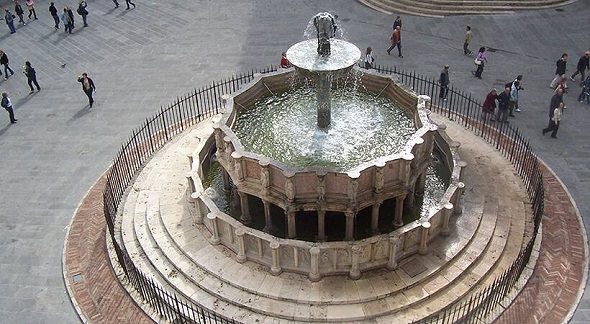
Piazza IV Novembre è ammantata dalla Cattedrale di San Lorenzo (D) e dall’imponente Palazzo dei Priori (C), dove ha sede dal 1878 la Galleria Nazionale dell’Umbria.
Costruita nel 1345, la Cattedrale di San Lorenzo è dedicata a uno dei patroni della città. Il lato della chiesa che si affaccia sulla piazza è in realtà la fiancata laterale, decorata soltanto nel lato inferiore da una trama geometrica di rombi di marmo rosa e bianco, mentre l’ingresso si trova in Piazza Danti. Nel chiostro ha sede il Museo Capitolare, tutte le informazioni nel nostro articolo dedicato alla Cattedrale.
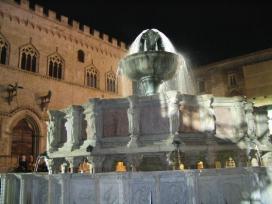
NON TUTTI SANNO CHE… >> Il pulpito del duomo è detto di San Bernardino, poiché fu proprio uno dei pulpiti delle prediche del Santo senese. L’influenza del Santo sulla città coincise con la stesura degli Statuta Bernardiniana di cui si dotò Perugia. Ovvero delle leggi comunali moralizzatrici, che vietavano i giochi e le balere.
Nella nostra miniguida su cosa vedere a Perugia non può mancare lo splendido Palazzo dei Priori, edificato in stile gotico tra il 1293 ed il 1443, uno dei migliori esempi di palazzo pubblico dell’età comunale. Vi si accede da Piazza IV Novembre, attraverso un portale duecentesco ornato dalle statue del grifo e del leone.
L’interno conserva ambienti di notevole interesse come la sala dei Notari, costituita da otto archi a tutto sesto aventi diverse pitture che narrano leggende, storie bibliche e massime.
Agli ultimi piani ha sede la Galleria Nazionale dell’Umbria, il cui ricco patrimonio artistico è organizzato secondo un percorso cronologico: al terzo piano sono raccolte le opere che vanno dal XIII al XV secolo, al secondo piano quelle dal XVI al XIX secolo. Fra tutte, spiccano i capolavori di Duccio di Buoninsegna, Piero della Francesca, Beato Angelico, il Pinturicchio e il Perugino, maestro di Raffaello.
Da Piazza IV Novembre parte Corso Vannucci, che con i suoi negozi e i suoi storici locali rappresenta il centro della vita sociale perugina.
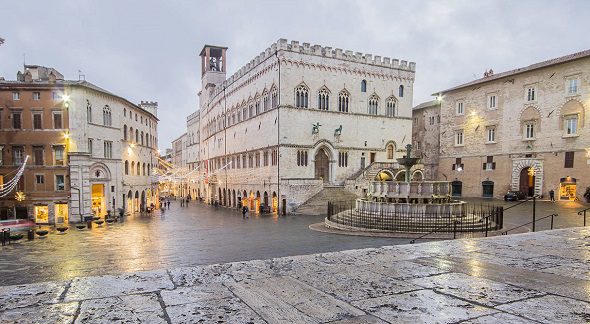
NON TUTTI SANNO CHE… >> Pietro Vannucci, detto il Perugino e il Pinturicchio hanno lasciato un loro autoritratto affrescato presso le sale del Collegio del Cambio, dentro Palazzo dei Priori, mimetizzandosi fra i banchieri raffigurati.
Cosa fare durante una visita a Perugia
Cosa fare a Perugia? Godetevi i locali e i negozi di Corso Vannucci e arrivati alla fine avventuratevi a visitare la Rocca Paolina (H), una vera e propria fortezza che venne fatta erigere da Papa Paolo III dopo il sacco di Roma. La sua costruzione rese necessaria la distruzione di più di cento case ma anche di monasteri e chiese. E’ stata il simbolo dell’autorità e del potere del Papa fino al 1860, anno dell’annessione al Regno d’Italia.
Vicino alla Fontana Maggiore, in Piazza Danti, non perdetevi il Pozzo Etrusco (E), incredibile opera idraulica costruita ben 300 anni prima della nascita di Cristo e perfettamente integra che scende sottoterra per 37 metri di profondità.
Se hai ancora del tempo a disposizione, sicuramente meritano una visita anche la Chiesa di San Domenico (I), l’Oratorio di San Bernardino (G), la Chiesa di Sant’Ercolano, la Basilica di San Pietro e la Cappella di San Severo (F).
Per approfondire ancora di più la conoscenza della città e dei suoi tesori artistici, ti consigliamo di prendere parte agli itinerari guidati organizzati da Sistema Museo, tra cui consigliamo il “Perugia Tour Città e Tesori d’Arte” che vi accompagnerà in un’immersione totale dell’arte e nella cultura perugine (ogni prima domenica del mese con partenza alle ore 10:00, su prenotazione).
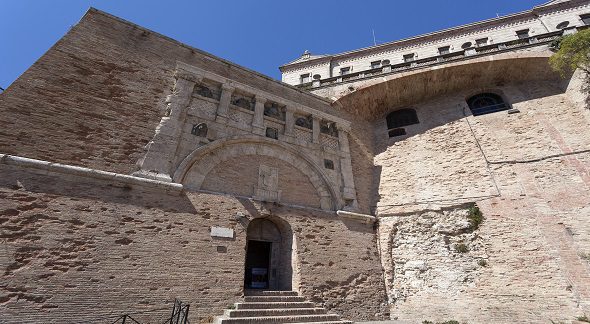
Perugia è nota anche per la Perugina, storico marchio di prodotti dolciari specializzato in cioccolato. Soprattutto se siete dei golosi, fate tappa alla Casa del Cioccolato per vivere un’esperienza unica! Il percorso dedicato al cioccolato inizia nel Museo Storico, per scoprirne storia e curiosità, e prosegue nella Scuola del Cioccolato dove potrai cimentarti in cucina e diventare un maestro cioccolatiero.
Tutta la città di Perugia si trasforma in una grande cioccolateria a cielo aperto nel mese di Ottobre, durante l’evento Eurochocolate interamente dedicato al cioccolato e al suo universo, tra stand, cooking show, eventi speciali, sculture di cioccolato, gadget a tema e molto altro!
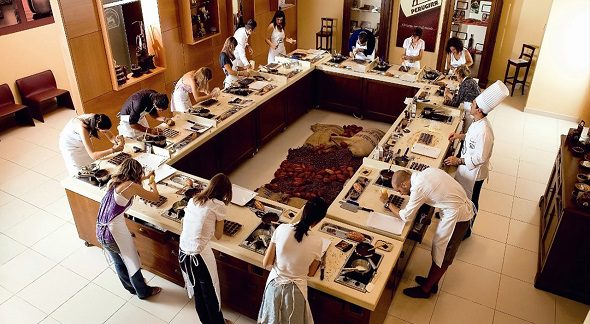
NON TUTTI SANNO CHE…>> Il celebre Bacio Perugina ha ottenuto il suo successo quando ne cambiarono il nome originale (che era cazzotto!) e si incominciarono a diffondere le belle confezioni dedicate agli innamorati ed ispirate al dipinto “il bacio” di Francesco Hayez.
Se siete appassionati di musica Jazz e non solo, inoltre, visitate Perugia nel mese di Luglio. In questo mese si tiene a Perugia il festival jazz più importante d’Italia: Umbria Jazz. In contemporanea con il festival si svolgono i seminari della Berklee Summer School at Umbria Jazz Clinics, organizzati dal Berklee College of Music di Boston.
Chiudiamo i nostri consigli su cosa fare a Perugia con un piccolo suggerimento, prezioso per gli amanti della fotografia: per scattare foto mozzafiato, non potete assolutamente perdere 3 punti panoramici unici di Assisi: i Giardini Carducci, la Porta del Sole e le Scale dell’Acquedotto.
Cosa Mangiare a Perugia?
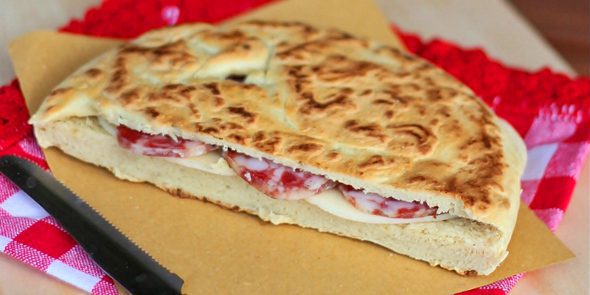
Il capoluogo umbro non manca certo di attrattive culinarie e la nostra miniguida ti proibisce di ripartire senza aver gustato almeno 3 specialità Perugine:
- Torta al Testo, al naturale o farcita con prosciutto, salsiccia cotta, verdure lessate, porchetta, stracchino e rucola;
- Strangozzi, (chiamati anche stringozzi o strozzapreti) fettuccine fatte in casa tipiche del territorio umbro, al tartufo o alla norcina;
- Cioccolata e Baci artigianali.
Se la miniguida ha soddisfatto la tua curiosità su cosa mangiare a Perugia sei pronto per gustarti degli splendidi panorami…
>> Consulta i ristoranti migliori nella zona di Perugia!
The best things to do in Perugia. Our mini-guide tells you what to see, what to do and what to eat to discover Perugia!
Perugia, with its steep medieval streets, breathtaking views and many delicious specialties to taste, has a lot to offer to its visitors. Our mini-guide offers a one day itinerary, full of curious anecdotes.
Ready? read on.

Arm yourself with flat shoes because in Perugia you have to walk many climbs to conquer the heart of the city, the amazing Piazza IV Novembre (A). Here, the first of the things to do in Perugia is admire the famous Fontana Maggiore (B). The symbol of the city, was built between 1275 and 1278 by Nicola and Giovanni Pisano on a circular staircase, consisting of two tanks pink and white stone surmounted by a hollow bronze from which emerge three nymphs holding up a jar. The tank rests on top of the columns from which rise statues of mythical characters related to the founding of the city, the fifty tiles that decorate the lower basin depict the timing of the agricultural work, some biblical, historical and mythological, the two symbols of the city ( the griffin) of the Guelph party (the lion) and the Empire (the eagle), the seven liberal arts and philosophy. Have fun finding in the tiles two scenes from Aesop’s Fables (cranes and wolf and wolf and lamb).
>> Do you want to visit Perugia? Check it out now of the best hotels in Perugia Italy
Piazza IV Novembre is cloaked from San Lorenzo Cathedral (D) and the imposing Palazzo dei Priori (C), which hosts since 1878 the National Gallery of Umbria. Built in 1345, San Lorenzo Cathedral is dedicated to one of the patrons of the city. The side of the church that overlooks the square is actually the side panel, decorated only on the bottom side with a geometric pattern of diamonds in pink and white marble, while the entrance is located in Piazza Danti.
Perhaps you did not know that… >>The pulpit of the Cathedral is called “of San Bernardino” because it was one of the pulpits of the sermons of the Saint. The influence of Saint Bernardino coincided with the drafting of Statuta Bernardiniana of which was endowed Perugia which prohibit gambling and dance halls.
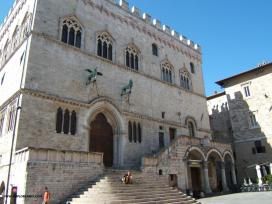
Built in Gothic style between 1293 and 1443, Palazzo dei Priori is one of the best examples of public buildings of the communal. You can access from Piazza IV Novembre, through a thirteenth-century portal decorated with the statues of the griffin and the lion. The interior contains different environments of considerable interest as the Notari Hall, composed of eight arches with different paintings that narrate legends, Biblical stories and maxims.
National Gallery of Umbria‘s artistic heritage is organized in chronological order: the top floors of the headquarters contain works from the thirteenth to the fifteenth century, on the second floor from the sixteenth to the nineteenth century. Among all, outstanding masterpieces by Duccio, Piero della Francesca, Fra Angelico, Pinturicchio and Perugino, Raphael’s teacher.
Perhaps you did not know that… >>Pietro Vannucci, better known as Perugino and Pinturicchio have left their self-portraits painted in the halls of Collegio del Cambio, inside Palazzo dei Priori, blending between the bankers depicted.
>> Do you want to discover Perugia’s treasures? Check it out now of the best farmhouse in Perugia.
From Piazza IV Novembre begins Corso Vannucci with its shops and locals, the center of social life in Perugia.
Perhaps you did not know that…>>The famous Bacio Perugina got his success when its originale name that was “punch” was changed in “kiss” and began to spread the fancy packages dedicated to lovers and inspired by Francesco Hayez’s painting “The Kiss”.
Things to do in Perugia
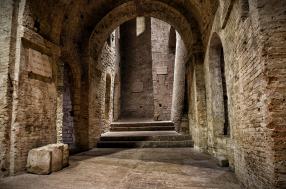
One of the best things to do in Perugia is discover Corso Vannucci’s locals and shops! Then we suggest you to visit Rocca Paolina (H), a fortress that was built by Pope Paul III after the sack of Rome. Its construction necessitated the destruction of more than a hundred homes but also of monasteries and churches. It was the symbol of authority and power of the Pope until 1860, the year of annexation to the Kingdom of Italy.
Near the Fontana Maggiore, in Piazza Danti, do not miss the Etruscan Well (E), incredible engineering work built 300 years before the birth of Christ and perfectly preserved, it descends underground for 37 feet deep.
Perhaps you did not know that…>> In July Perugia hosts the most important of Italian jazz festivals: Umbria Jazz.
>> There are offers for vacation rentals and hotels in the areas of Perugia! Click and Consult them immediately.
If you have some time left we suggest you other things to do in Perugia like visit Saint Domenico’s Church (I) , the Oratory of San Bernardino (G), Saint Ercolano’s Church, St. Peter’s Basilica and San Severo Chapel (F).
Perugia’s food, Umbrian cuisine, Italian food
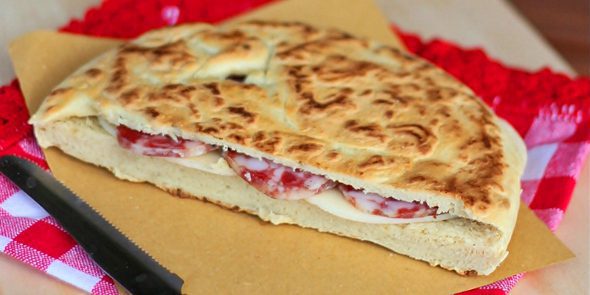
Perugia has a lot of delicious typical things to eat and it is forbidden to leave Perugia without having tasted at least 3 culinary delights:
- Torta al Testo, plain or stuffed with ham, cooked sausage, boiled vegetables, pork and cheese
- Strangozzi, (also called Strozzapreti) homemade noodles typical of Umbria, with truffle or “alla norcina”
- Chocolate and crafts Baci Perugina
After have tasted all the best Perugia’s food, we suggest you the best views for breathtaking photos: Giardini Carducci, Porta Sole, Aqueduct Stairs.
>>If you’ve decided to visit Perugia and Umbrian cuisine you should contact now farmhouses near Perugia >> Click this link.
The best things to do in Perugia. Our mini-guide tells you what to see, what to do and what to eat to discover Perugia!
Perugia, with its steep medieval streets, breathtaking views and many delicious specialties to taste, has a lot to offer to its visitors. Our mini-guide offers a one day itinerary, full of curious anecdotes.
Ready? read on!
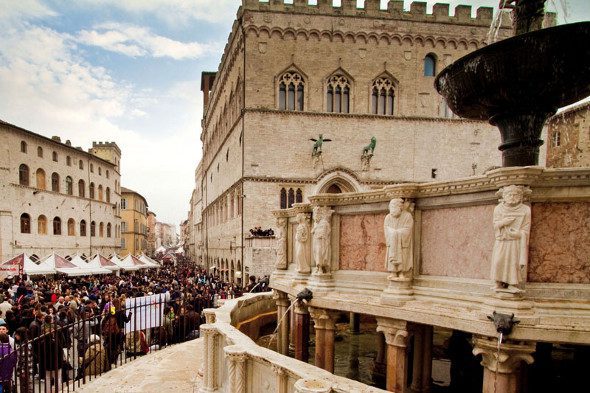
Arm yourself with flat shoes because in Perugia you have to walk many climbs to conquer the heart of the city, the amazing Piazza IV Novembre. Here, the first of the things to do in Perugia is admire the famous Fontana Maggiore . The symbol of the city, was built between 1275 and 1278 by Nicola and Giovanni Pisano on a circular staircase, consisting of two tanks pink and white stone surmounted by a hollow bronze from which emerge three nymphs holding up a jar. The tank rests on top of the columns from which rise statues of mythical characters related to the founding of the city, the fifty tiles that decorate the lower basin depict the timing of the agricultural work, some biblical, historical and mythological, the two symbols of the city ( the griffin) of the Guelph party (the lion) and the Empire (the eagle), the seven liberal arts and philosophy. Have fun finding in the tiles two scenes from Aesop’s Fables (cranes and wolf and wolf and lamb).
>> Do you want to visit Perugia? Check it out now of the best hotels in Perugia Italy
Piazza IV Novembre is cloaked from San Lorenzo Cathedral (D) and the imposing Palazzo dei Priori (C), which hosts since 1878 the National Gallery of Umbria. Built in 1345, San Lorenzo Cathedral is dedicated to one of the patrons of the city. The side of the church that overlooks the square is actually the side panel, decorated only on the bottom side with a geometric pattern of diamonds in pink and white marble, while the entrance is located in Piazza Danti.
Perhaps you did not know that… >>The pulpit of the Cathedral is called “of San Bernardino” because it was one of the pulpits of the sermons of the Saint. The influence of Saint Bernardino coincided with the drafting of Statuta Bernardiniana of which was endowed Perugia which prohibit gambling and dance halls.
Built in Gothic style between 1293 and 1443, Palazzo dei Priori is one of the best examples of public buildings of the communal. You can access from Piazza IV Novembre, through a thirteenth-century portal decorated with the statues of the griffin and the lion. The interior contains different environments of considerable interest as the Notari Hall, composed of eight arches with different paintings that narrate legends, Biblical stories and maxims.
National Gallery of Umbria‘s artistic heritage is organized in chronological order: the top floors of the headquarters contain works from the thirteenth to the fifteenth century, on the second floor from the sixteenth to the nineteenth century. Among all, outstanding masterpieces by Duccio, Piero della Francesca, Fra Angelico, Pinturicchio and Perugino, Raphael’s teacher.
Perhaps you did not know that… >>Pietro Vannucci, better known as Perugino and Pinturicchio have left their self-portraits painted in the halls of Collegio del Cambio, inside Palazzo dei Priori, blending between the bankers depicted.
>> Do you want to discover Perugia’s treasures? Check it out now of the best farmhouse in Perugia.
From Piazza IV Novembre begins Corso Vannucci with its shops and locals, the center of social life in Perugia.
Perhaps you did not know that…>>The famous Bacio Perugina got his success when its originale name that was “punch” was changed in “kiss” and began to spread the fancy packages dedicated to lovers and inspired by Francesco Hayez’s painting “The Kiss”.
Things to do in Perugia
One of the best things to do in Perugia is discover Corso Vannucci’s locals and shops! Then we suggest you to visit Rocca Paolina (H), a fortress that was built by Pope Paul III after the sack of Rome. Its construction necessitated the destruction of more than a hundred homes but also of monasteries and churches. It was the symbol of authority and power of the Pope until 1860, the year of annexation to the Kingdom of Italy.
Near the Fontana Maggiore, in Piazza Danti, do not miss the Etruscan Well (E), incredible engineering work built 300 years before the birth of Christ and perfectly preserved, it descends underground for 37 feet deep.
Perhaps you did not know that…>> In July Perugia hosts the most important of Italian jazz festivals: Umbria Jazz.
>> There are offers for vacation rentals and hotels in the areas of Perugia! Click and Consult them immediately.
If you have some time left we suggest you other things to do in Perugia like visit Saint Domenico’s Church (I) , the Oratory of San Bernardino (G), Saint Ercolano’s Church, St. Peter’s Basilica and San Severo Chapel (F).
Perugia’s food, Umbrian cuisine, Italian food

Perugia has a lot of delicious typical things to eat and it is forbidden to leave Perugia without having tasted at least 3 culinary delights:
- Torta al Testo, plain or stuffed with ham, cooked sausage, boiled vegetables, pork and cheese
- Strangozzi, (also called Strozzapreti) homemade noodles typical of Umbria, with truffle or “alla norcina”
- Chocolate and crafts Baci Perugina
The best things to do in Perugia. Our mini-guide tells you what to see, what to do and what to eat to discover Perugia!
Perugia, with its steep medieval streets, breathtaking views and many delicious specialties to taste, has a lot to offer to its visitors. Our mini-guide offers a one day itinerary, full of curious anecdotes.
Ready? read on!

Arm yourself with flat shoes because in Perugia you have to walk many climbs to conquer the heart of the city, the amazing Piazza IV Novembre. Here, the first of the things to do in Perugia is admire the famous Fontana Maggiore . The symbol of the city, was built between 1275 and 1278 by Nicola and Giovanni Pisano on a circular staircase, consisting of two tanks pink and white stone surmounted by a hollow bronze from which emerge three nymphs holding up a jar. The tank rests on top of the columns from which rise statues of mythical characters related to the founding of the city, the fifty tiles that decorate the lower basin depict the timing of the agricultural work, some biblical, historical and mythological, the two symbols of the city ( the griffin) of the Guelph party (the lion) and the Empire (the eagle), the seven liberal arts and philosophy. Have fun finding in the tiles two scenes from Aesop’s Fables (cranes and wolf and wolf and lamb).
>> Do you want to visit Perugia? Check it out now of the best hotels in Perugia Italy
Piazza IV Novembre is cloaked from San Lorenzo Cathedral (D) and the imposing Palazzo dei Priori (C), which hosts since 1878 the National Gallery of Umbria. Built in 1345, San Lorenzo Cathedral is dedicated to one of the patrons of the city. The side of the church that overlooks the square is actually the side panel, decorated only on the bottom side with a geometric pattern of diamonds in pink and white marble, while the entrance is located in Piazza Danti.
Perhaps you did not know that… >>The pulpit of the Cathedral is called “of San Bernardino” because it was one of the pulpits of the sermons of the Saint. The influence of Saint Bernardino coincided with the drafting of Statuta Bernardiniana of which was endowed Perugia which prohibit gambling and dance halls.
Built in Gothic style between 1293 and 1443, Palazzo dei Priori is one of the best examples of public buildings of the communal. You can access from Piazza IV Novembre, through a thirteenth-century portal decorated with the statues of the griffin and the lion. The interior contains different environments of considerable interest as the Notari Hall, composed of eight arches with different paintings that narrate legends, Biblical stories and maxims.
National Gallery of Umbria‘s artistic heritage is organized in chronological order: the top floors of the headquarters contain works from the thirteenth to the fifteenth century, on the second floor from the sixteenth to the nineteenth century. Among all, outstanding masterpieces by Duccio, Piero della Francesca, Fra Angelico, Pinturicchio and Perugino, Raphael’s teacher.
Perhaps you did not know that… >>Pietro Vannucci, better known as Perugino and Pinturicchio have left their self-portraits painted in the halls of Collegio del Cambio, inside Palazzo dei Priori, blending between the bankers depicted.
>> Do you want to discover Perugia’s treasures? Check it out now of the best farmhouse in Perugia.
From Piazza IV Novembre begins Corso Vannucci with its shops and locals, the center of social life in Perugia.
Perhaps you did not know that…>>The famous Bacio Perugina got his success when its originale name that was “punch” was changed in “kiss” and began to spread the fancy packages dedicated to lovers and inspired by Francesco Hayez’s painting “The Kiss”.
Things to do in Perugia
One of the best things to do in Perugia is discover Corso Vannucci’s locals and shops! Then we suggest you to visit Rocca Paolina (H), a fortress that was built by Pope Paul III after the sack of Rome. Its construction necessitated the destruction of more than a hundred homes but also of monasteries and churches. It was the symbol of authority and power of the Pope until 1860, the year of annexation to the Kingdom of Italy.
Near the Fontana Maggiore, in Piazza Danti, do not miss the Etruscan Well (E), incredible engineering work built 300 years before the birth of Christ and perfectly preserved, it descends underground for 37 feet deep.
Perhaps you did not know that…>> In July Perugia hosts the most important of Italian jazz festivals: Umbria Jazz.
>> There are offers for vacation rentals and hotels in the areas of Perugia! Click and Consult them immediately.
If you have some time left we suggest you other things to do in Perugia like visit Saint Domenico’s Church (I) , the Oratory of San Bernardino (G), Saint Ercolano’s Church, St. Peter’s Basilica and San Severo Chapel (F).
Perugia’s food, Umbrian cuisine, Italian food

Perugia has a lot of delicious typical things to eat and it is forbidden to leave Perugia without having tasted at least 3 culinary delights:
- Torta al Testo, plain or stuffed with ham, cooked sausage, boiled vegetables, pork and cheese
- Strangozzi, (also called Strozzapreti) homemade noodles typical of Umbria, with truffle or “alla norcina”
- Chocolate and crafts Baci Perugina
The best things to do in Perugia. Our mini-guide tells you what to see, what to do and what to eat to discover Perugia!
Perugia, with its steep medieval streets, breathtaking views and many delicious specialties to taste, has a lot to offer to its visitors. Our mini-guide offers a one day itinerary, full of curious anecdotes.
Ready? read on!

Arm yourself with flat shoes because in Perugia you have to walk many climbs to conquer the heart of the city, the amazing Piazza IV Novembre. Here, the first of the things to do in Perugia is admire the famous Fontana Maggiore . The symbol of the city, was built between 1275 and 1278 by Nicola and Giovanni Pisano on a circular staircase, consisting of two tanks pink and white stone surmounted by a hollow bronze from which emerge three nymphs holding up a jar. The tank rests on top of the columns from which rise statues of mythical characters related to the founding of the city, the fifty tiles that decorate the lower basin depict the timing of the agricultural work, some biblical, historical and mythological, the two symbols of the city ( the griffin) of the Guelph party (the lion) and the Empire (the eagle), the seven liberal arts and philosophy. Have fun finding in the tiles two scenes from Aesop’s Fables (cranes and wolf and wolf and lamb).
>> Do you want to visit Perugia? Check it out now of the best hotels in Perugia Italy
Piazza IV Novembre is cloaked from San Lorenzo Cathedral (D) and the imposing Palazzo dei Priori (C), which hosts since 1878 the National Gallery of Umbria. Built in 1345, San Lorenzo Cathedral is dedicated to one of the patrons of the city. The side of the church that overlooks the square is actually the side panel, decorated only on the bottom side with a geometric pattern of diamonds in pink and white marble, while the entrance is located in Piazza Danti.
Perhaps you did not know that… >>The pulpit of the Cathedral is called “of San Bernardino” because it was one of the pulpits of the sermons of the Saint. The influence of Saint Bernardino coincided with the drafting of Statuta Bernardiniana of which was endowed Perugia which prohibit gambling and dance halls.
Built in Gothic style between 1293 and 1443, Palazzo dei Priori is one of the best examples of public buildings of the communal. You can access from Piazza IV Novembre, through a thirteenth-century portal decorated with the statues of the griffin and the lion. The interior contains different environments of considerable interest as the Notari Hall, composed of eight arches with different paintings that narrate legends, Biblical stories and maxims.
National Gallery of Umbria‘s artistic heritage is organized in chronological order: the top floors of the headquarters contain works from the thirteenth to the fifteenth century, on the second floor from the sixteenth to the nineteenth century. Among all, outstanding masterpieces by Duccio, Piero della Francesca, Fra Angelico, Pinturicchio and Perugino, Raphael’s teacher.
Perhaps you did not know that… >>Pietro Vannucci, better known as Perugino and Pinturicchio have left their self-portraits painted in the halls of Collegio del Cambio, inside Palazzo dei Priori, blending between the bankers depicted.
>> Do you want to discover Perugia’s treasures? Check it out now of the best farmhouse in Perugia.
From Piazza IV Novembre begins Corso Vannucci with its shops and locals, the center of social life in Perugia.
Perhaps you did not know that…>>The famous Bacio Perugina got his success when its originale name that was “punch” was changed in “kiss” and began to spread the fancy packages dedicated to lovers and inspired by Francesco Hayez’s painting “The Kiss”.
Things to do in Perugia
One of the best things to do in Perugia is discover Corso Vannucci’s locals and shops! Then we suggest you to visit Rocca Paolina (H), a fortress that was built by Pope Paul III after the sack of Rome. Its construction necessitated the destruction of more than a hundred homes but also of monasteries and churches. It was the symbol of authority and power of the Pope until 1860, the year of annexation to the Kingdom of Italy.
Near the Fontana Maggiore, in Piazza Danti, do not miss the Etruscan Well (E), incredible engineering work built 300 years before the birth of Christ and perfectly preserved, it descends underground for 37 feet deep.
Perhaps you did not know that…>> In July Perugia hosts the most important of Italian jazz festivals: Umbria Jazz.
>> There are offers for vacation rentals and hotels in the areas of Perugia! Click and Consult them immediately.
If you have some time left we suggest you other things to do in Perugia like visit Saint Domenico’s Church (I) , the Oratory of San Bernardino (G), Saint Ercolano’s Church, St. Peter’s Basilica and San Severo Chapel (F).
Perugia’s food, Umbrian cuisine, Italian food

Perugia has a lot of delicious typical things to eat and it is forbidden to leave Perugia without having tasted at least 3 culinary delights:
- Torta al Testo, plain or stuffed with ham, cooked sausage, boiled vegetables, pork and cheese
- Strangozzi, (also called Strozzapreti) homemade noodles typical of Umbria, with truffle or “alla norcina”
- Chocolate and crafts Baci Perugina

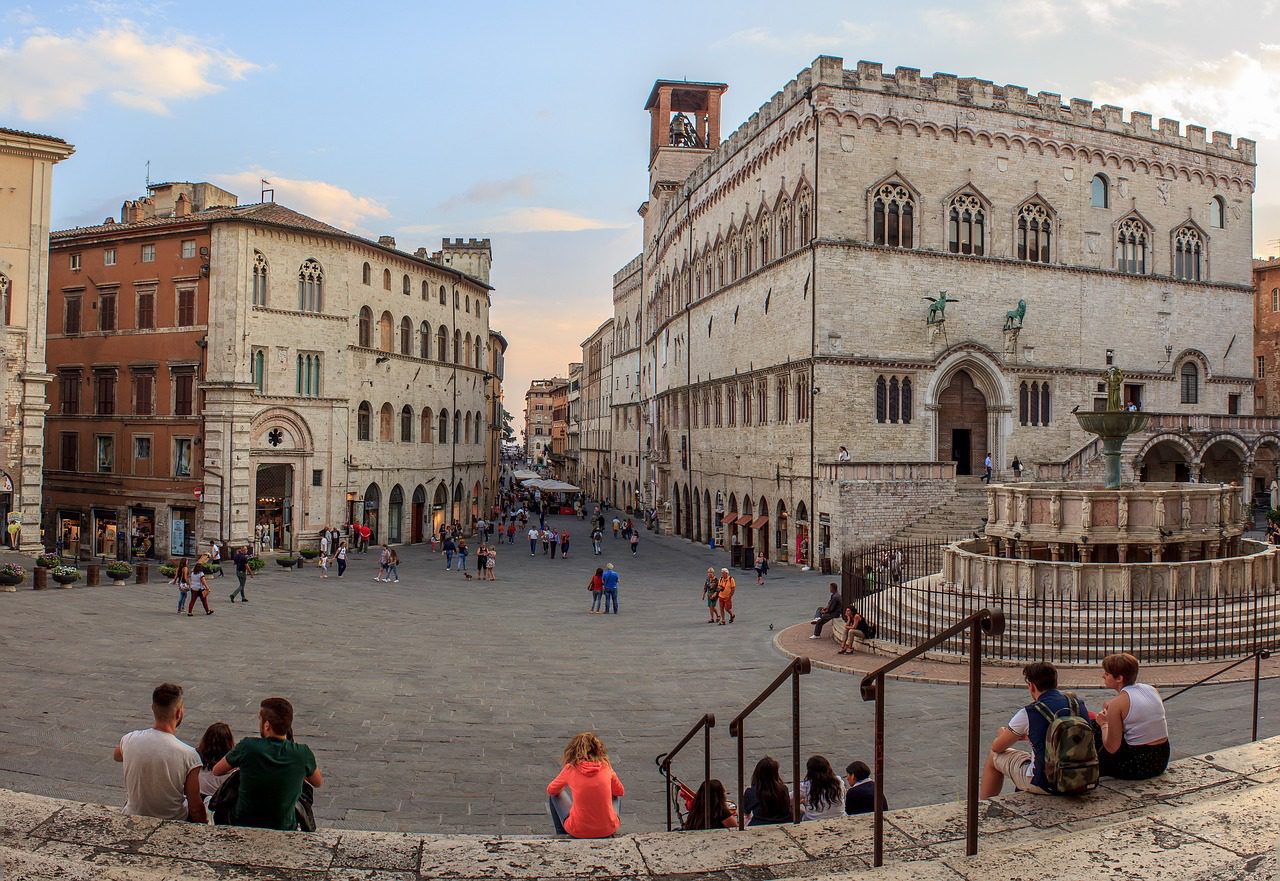










Comment (0)